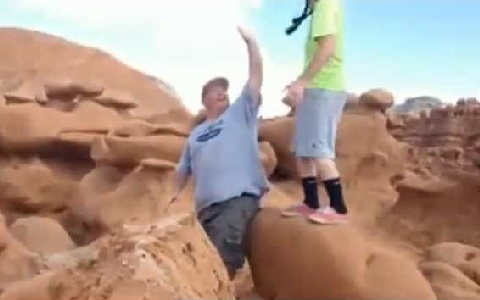By Greta Hyland

By now it is common knowledge that three Boy Scout leaders, in an irresponsible and unthinking act, pushed over a boulder in Goblin Valley State Park. After they aired it on YouTube, echoes of outrage reverberated not just around the nation but around the world. The dialogue has largely centered on the issue of justice, but the underlying, unspoken issue is the value of the thing they destroyed. In academic discussions, largely outside of the public eye, the issue of intrinsic worth is hotly debated by environmental ethicists, economists and philosophers. What many question is how to gauge the value of a thing that cannot be expressed in a dollar amount. When discussing policy within a capitalist society that ascertains value based on what people are willing to pay, it becomes convoluted and tricky. Because most things are worked out by numbers in the market, the discussion changes from one of mathematics to one of ethics when a dollar amount cannot account for worth. So what of those things that are valuable but cannot be summed up in a bank account?
One can argue that a thing only has value if there is someone who values it. This argument bothers many environmentalists, who believe that a thing has value regardless of peoples’ acknowledgement of it, but our country has a long history of placing great value on such things as natural landscapes, beautiful vistas and geologic majesty so, intrinsic or not, we have collectively determined these inanimate things to be of great worth. This idea of valuing our lands has been expressed by famous people such as Teddy Roosevelt and through acts such as the National Parks system. But we all inherently understand this on a personal level. When a house burns down, the loss of the house and possessions is awful, but it’s the loss of the irreplaceable things such as photos and journals that make us weep, because those are the things that cannot be rebought at a store. So perhaps we should start thinking about what it costs us to lose something irreplaceable outside our homes. What is Zion National Park worth? Not the lost dollars of entrance fees but the loss of memories, adventures and good times experienced in the canyons of that park. What of the loss of a place where annual family reunions are held? There is no price tag big enough for these things because they are priceless. These questions need to be thought about – not just in light of vandalism but always, because our lands are constantly at risk.
In light of the goblin slayers, we should ask ourselves not only what justice should be meted out but what value we should place on those lands, because like journals of ancestors they are irreplaceable. It is not just that a rock got toppled but that a mentality was revealed. It is that mentality that threatens other spectacular landscapes found in this state, and since thoughts lead to actions we must question the often unevaluated beliefs below the surface. While we can argue what a just punishment is for the men who committed this wanton act of destruction, we should reflect on the consequences and after-effect of such actions and how such a mentality puts at risk the places we hold dear. As Wallace Stegner famously said, “Something will have gone out of us as a people if we ever let the remaining wilderness be destroyed – we simply need that wild country available to us, even if we never do more than drive to its edge and look in.”




